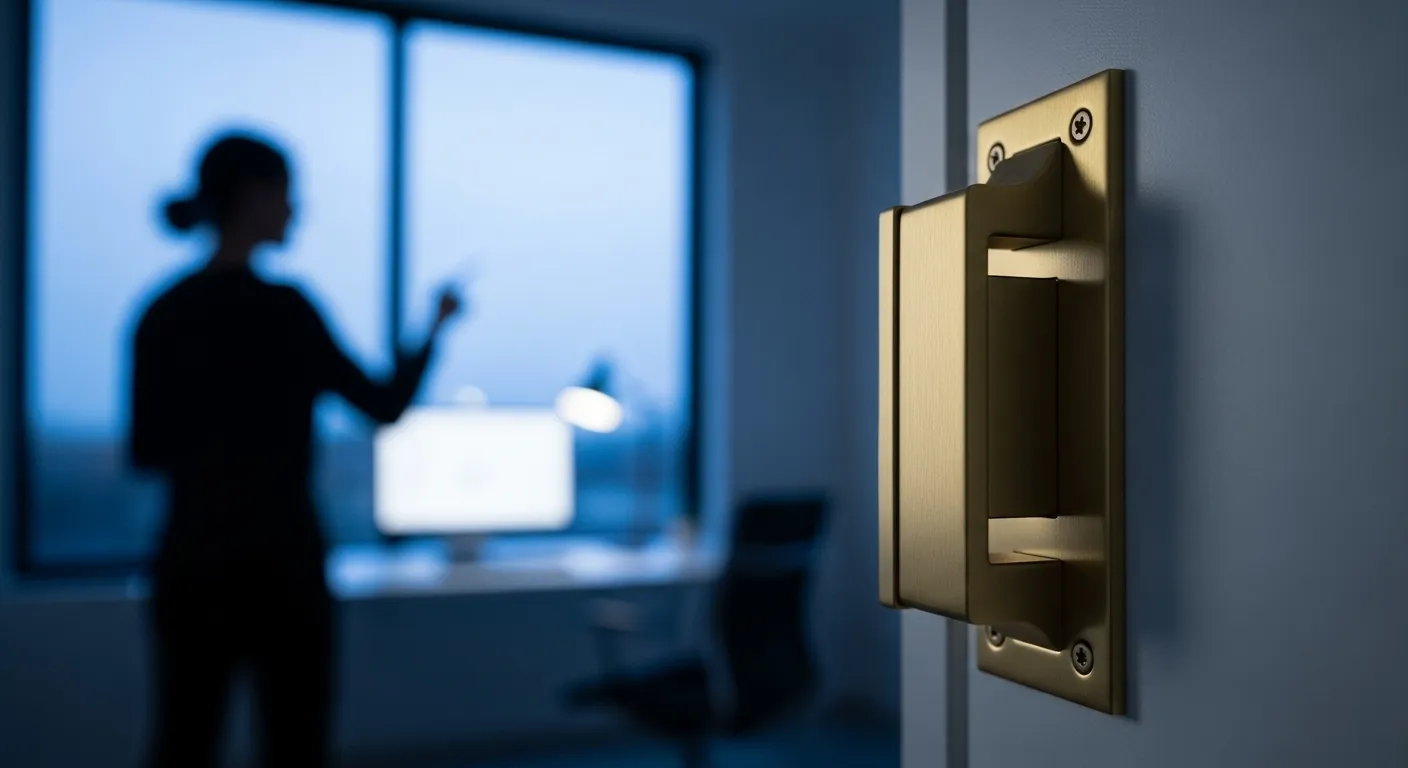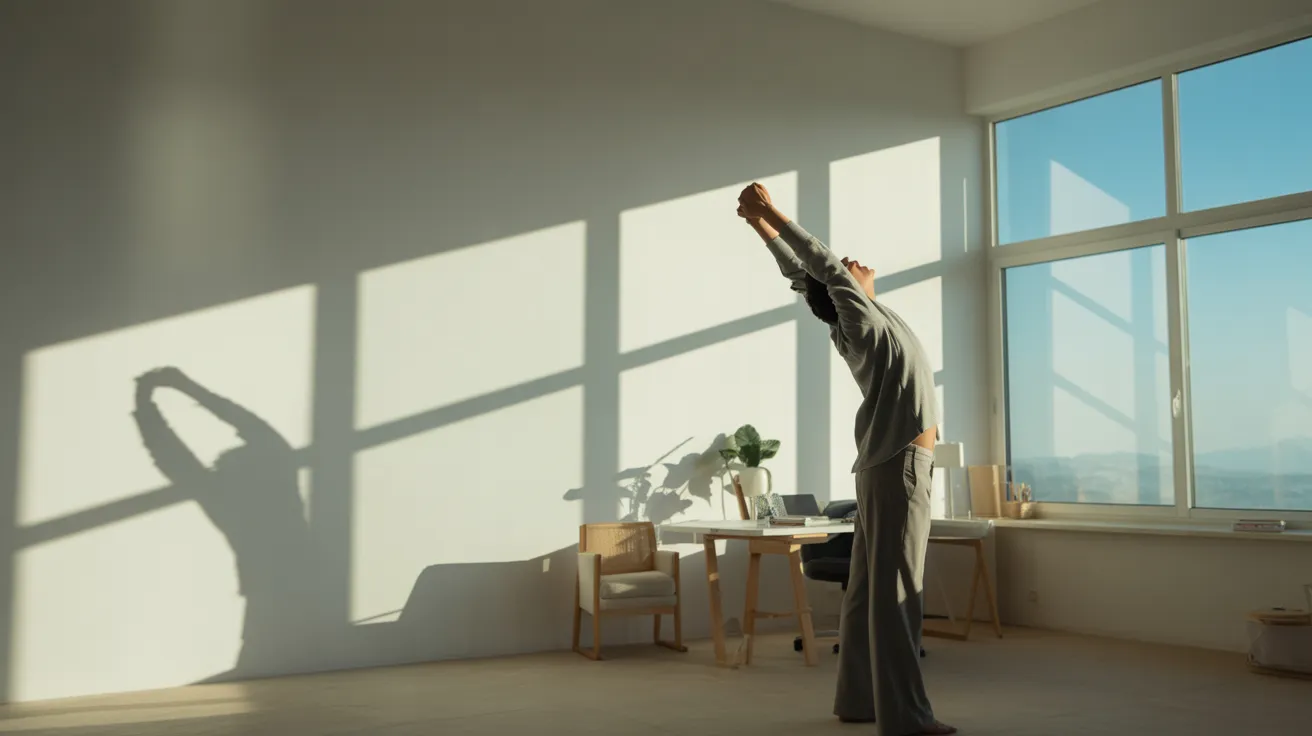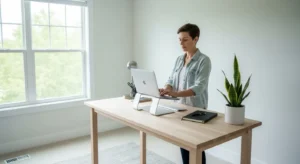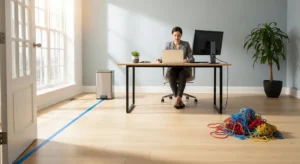
You open your closet doors and a wave of silent chaos greets you. Hangers are crammed together, clothes you haven’t worn in years sit beside new purchases with the tags still on, and a familiar sense of overwhelm sets in. You have a closet full of clothes, yet you have nothing to wear. This daily experience isn’t a personal failing; it’s a system failure. The clutter in our closets creates what we at The Focused Method call visual friction: a low-grade, persistent stress caused by disorganized environments. It drains your mental energy before your day has even truly begun.
The constant question of “what to wear?” is a perfect example of decision fatigue. Every small choice we make throughout the day chips away at our finite supply of willpower and focus. When you start your morning by sorting through dozens of options, you’re spending precious cognitive resources on a task that could be effortless. The solution isn’t more clothes or a bigger closet. The solution is a better system. This is the promise of a capsule wardrobe: a thoughtfully curated collection of versatile items you love, designed to work together seamlessly. It’s not about restriction; it’s about intentionality. It’s a system designed to eliminate friction and give you back your time, money, and mental clarity.
This guide isn’t about following rigid rules or chasing a minimalist aesthetic for its own sake. It’s about building a practical, low-maintenance framework that serves your life. We will explore how to design this system for yourself, focusing on environmental cues over sheer willpower. You will learn to create a wardrobe that feels calm, makes getting dressed the easiest part of your day, and aligns with a more sustainable and simple way of living. Forget the endless cycle of trends and impulse buys. Let’s build a system that works for you, not against you.
📚 Table of Contents
- The Philosophy of a Capsule Wardrobe: A System for Simplicity
- The Foundation: A Systematic Declutter of Your Current Wardrobe
- Building Your First Capsule: A Practical, Step-by-Step Guide
- Maintaining the System: Daily, Weekly, and Seasonal Resets
- Frequently Asked Questions About Capsule Wardrobes
- Conclusion: Your First Steps Toward a Simpler Wardrobe
The Philosophy of a Capsule Wardrobe: A System for Simplicity
Before we start pulling clothes from hangers, it’s crucial to understand the “why” behind this method. A capsule wardrobe is often mistaken for a purely minimalist trend, but at its core, it is a powerful organizational system. Its primary goal is to drastically reduce decision fatigue and create a life with less friction. Think of your brainpower as a battery. Every decision you make, from choosing your breakfast to negotiating a contract at work, drains a small amount of that battery. A cluttered, chaotic closet forces you into a dozen micro-decisions—color combinations, fit, weather appropriateness, style—all before you’ve had your first cup of coffee. A capsule wardrobe for simplicity pre-makes most of those decisions for you.
So, what is it? A capsule wardrobe is a small, curated collection of essential, high-quality, and interchangeable clothing items that you absolutely love and that reflect your personal style. The pieces are chosen to be versatile, allowing you to create a wide variety of outfits from a limited number of items. This system typically revolves around a chosen color palette, ensuring everything complements everything else. It’s the ultimate mix-and-match closet.
The benefits extend far beyond a tidy closet. First, you save an incredible amount of time and mental energy each morning. Getting dressed becomes a five-minute, stress-free task. Second, you save money. By focusing on intentional, high-quality purchases, you stop wasting money on fast-fashion trends and items that you wear once and forget. This leads to a third, significant benefit: sustainability. A capsule wardrobe encourages a more conscious approach to consumption. You buy less, choose better, and make it last. For those interested in the impact of their choices, resources like Good On You offer great insights into ethical and sustainable brands.
At The Focused Method, we believe in creating supportive environments. Instead of relying on discipline to overcome a flawed system, we change the system itself. Your wardrobe is one of the most powerful systems you interact with daily. By curating it, you are creating an environmental cue for calm and order. Your closet becomes a working zone—a space designed for a specific, efficient purpose: getting you dressed with ease. The visual friction of a cluttered space is replaced by the visual calm of an organized one, setting a positive tone for your entire day.

The Foundation: A Systematic Declutter of Your Current Wardrobe
The first step toward building your capsule wardrobe is the most daunting, but also the most liberating: decluttering what you already own. This isn’t just about tidying up; it’s a strategic process of evaluation and elimination to create the blank slate you need. We will approach this with a system that minimizes second-guessing and emotional turmoil.
First, you must see everything you have. Schedule a few hours, put on some music, and pull every single piece of clothing out of your closet, your drawers, and any other storage space. Pile it all on your bed. This step is non-negotiable. Seeing the sheer volume of what you own is a powerful catalyst for change. It physically demonstrates the weight of your wardrobe and breaks the “out of sight, out of mind” spell that keeps unworn items in your life for years.
Next, prepare four distinct sorting zones: a “Keep” pile, a “Maybe” box, a “Donate/Sell” bag, and a “Sentimental” box. Now, pick up each item one by one and make a decision. The “Keep” pile is exclusively for items you love, that fit you well right now, and that you wear regularly. Be honest with yourself. If you haven’t worn it in a year, it doesn’t belong here. For every item you decide to discard, apply the one-touch rule. This means once you’ve decided an item’s fate (e.g., to donate), it goes immediately into the designated bag. Do not put it aside to “reconsider” later. This simple habit prevents churn and makes your decisions final and efficient.
The “Maybe” box is your pressure-release valve. It’s for items you’re struggling to part with. Perhaps it was expensive, or you think you might fit into it again someday. Put these items in a box, label it with a date six months from now, and store it out of sight. If you don’t think about or need any of those items during that time, you can confidently let them go without ever opening the box again. This is a compassionate way to deal with indecision.
The “Sentimental” box is for items you don’t wear but can’t bear to part with, like a wedding dress or a concert t-shirt from your youth. These are memories, not wardrobe items. They should be stored and honored as such, perhaps in a memory box, but they should not be taking up valuable real estate in your working closet and contributing to visual friction. Once your sort is complete, take the “Donate/Sell” bags out to your car immediately. This completes the one-touch process and prevents them from creeping back into your home.

Building Your First Capsule: A Practical, Step-by-Step Guide
With a clean slate and a curated pile of your favorite clothes, you are now ready to build your capsule. This is the creative and strategic part of the process. This is where you transform a collection of clothes into a cohesive, functional system. This minimalist wardrobe guide is designed to be flexible and adaptable to your unique needs.
Step 1: Define Your Lifestyle and Personal Style. Your wardrobe must serve the life you actually live, not an idealized version of it. Take a moment to think about your typical week. What percentage of your time is spent at work, at home, socializing, or being active? If you work from home 90% of the time, your capsule shouldn’t be 90% business suits. Your clothing needs to be practical. Simultaneously, consider your personal style. What makes you feel confident and comfortable? Look at your “Keep” pile for clues. Are you drawn to classic silhouettes, bohemian textures, or modern, clean lines? Write down three to five words that describe your ideal style (e.g., “classic, comfortable, natural”).
Step 2: Choose a Cohesive Color Palette. This is the secret to making a small wardrobe feel expansive. A good color palette ensures everything mixes and matches effortlessly. A common strategy is to choose one or two neutral base colors (like black, navy, grey, or beige) that will form the foundation of your wardrobe, primarily for items like trousers, coats, and shoes. Then, select a few complementary accent colors for your tops and accessories. These are the colors that you love and that flatter you. Having this defined palette makes shopping and creating outfits incredibly simple.
Step 3: Determine Your Ideal Number of Items. There is no magic number. Some people aim for 33 items, others for 50. The right number for you depends on your lifestyle, climate, and laundry habits. A great starting point for a seasonal capsule is around 35-40 items. This typically includes tops, bottoms, dresses, outerwear, and shoes. It does not include workout clothes, underwear, sleepwear, or special occasion wear. Don’t get fixated on a specific number; focus on having a functional collection where every piece earns its place.
Step 4: Create a List and “Shop” Your Closet. Based on your lifestyle, style, and color palette, make a specific list of what your ideal capsule would contain. For example: two pairs of dark jeans, one pair of black trousers, one skirt, four neutral t-shirts, three blouses, two sweaters, one blazer, one trench coat, etc. Once you have your list, go back to your “Keep” pile. “Shop” from what you already own and check off the items on your list. You will likely find that you already have a strong foundation for your capsule.
Step 5: Fill the Gaps Intentionally. After shopping your own closet, you’ll have a much shorter, more targeted list of items you truly need. This is where intentional purchasing comes in. Instead of buying on impulse, you are now strategically acquiring pieces that fill a specific role in your wardrobe system. Focus on finding the best quality you can afford. A well-made classic trench coat will serve you better and longer than five trendy, cheap jackets. This slow, thoughtful approach to shopping is the cornerstone of maintaining a simple, effective capsule wardrobe long-term.

Maintaining the System: Daily, Weekly, and Seasonal Resets
A beautiful capsule wardrobe is one thing; keeping it functional and orderly is another. This is where the power of simple habits and routines comes into play. To prevent your closet from slowly descending back into chaos, we need to establish reset points. A reset point is a designated time or trigger to bring a system back to its ideal, baseline state. For your wardrobe, these resets happen on a daily, weekly, and seasonal basis, and they require very little willpower once they become automatic.
The Daily Reset is a simple, two-minute habit that prevents clutter build-up. At the end of the day, instead of draping clothes over a chair (creating the dreaded “chair-drobe”), take two minutes to put everything back in its designated home. Hang up your jacket, put your shoes on the rack, and place worn-but-not-dirty clothes in a specific spot (like a hook on the back of the door) to be worn again before washing. This tiny action completely eliminates the visual friction of clothes piles and ensures your bedroom remains a calm, restful space. It’s a habit that signals the end of the day and keeps your system in perfect working order.
The Weekly Reset is naturally built into your laundry schedule. The process of washing, drying, and folding or hanging your clothes is the perfect opportunity to reset your entire wardrobe system. As you put clean clothes away, you are quite literally putting your system back in order. Take an extra five minutes during this process to straighten up your closet. Re-fold any messy sweaters, neaten your shoe rack, and ensure hangers are spaced evenly. This weekly touchpoint keeps things from getting out of hand and reinforces the sense of order and calm your capsule is designed to create.
The Seasonal Reset is the biggest, yet most rewarding, maintenance habit. This happens two to four times a year, depending on your climate, as you transition between seasons. This is your opportunity to conduct a mini-audit of your capsule. First, pack away the off-season items. As you do, inspect them for wear and tear. Do any items need to be mended or replaced? Make a note. Next, bring out your clothes for the upcoming season. Go through them with a critical eye. Do you still love each piece? Does it fit your current lifestyle? This is the time to reassess and make adjustments. Perhaps you’ve started a new job or hobby that requires different types of clothing. By thoughtfully managing these seasonal transitions, you ensure your capsule wardrobe continues to be a perfectly tailored system that evolves with you, rather than a rigid set of rules you have to fight against.

Frequently Asked Questions About Capsule Wardrobes
Embarking on a journey to simplify your wardrobe often brings up practical questions and concerns. Here are answers to some of the most common queries we encounter, helping you navigate the transition with confidence and ease.
How should I handle sentimental items that I don’t wear but can’t bear to part with?
This is a deeply personal and important question. A capsule wardrobe is for the clothes you wear; sentimental items are artifacts of your life story. They deserve to be treated with honor, not crammed between work blouses and weekend jeans where they create clutter and guilt. The solution is to create a dedicated home for them. A beautiful memory box or a designated storage bin is a perfect place for a wedding dress, a favorite concert t-shirt, or a baby’s first outfit. By giving these items their own special “zone,” you remove them from your working wardrobe, eliminating that visual friction while still preserving the memories you cherish.
My partner and I share a small closet. How can I create a capsule if they aren’t on board?
You can only control your own systems. The key here is to focus on your designated space within the shared closet. Create a clear visual boundary, even if it’s just an imaginary line. Apply all the capsule wardrobe principles to your half. The immediate visual impact of your organized, spacious section will be profound. Often, leading by example is the most powerful form of persuasion. When your partner sees how much less stressed and how much faster you get ready in the morning, they may become curious. The benefit of having more physical space on their side of the closet can also be a gentle motivator. Focus on your system, and don’t try to force theirs.
I live in a small apartment with very limited storage. How can I manage off-season capsules?
Small spaces demand clever systems. The key is to maximize unused storage potential. Slim, under-the-bed storage containers are perfect for off-season clothes. Vacuum-sealed bags can dramatically reduce the volume of bulky items like sweaters and coats, allowing them to be stored on a high shelf or at the back of a closet. Think vertically. Is there space above your closet rod for another shelf? Can you use the back of a door for hanging shoe or accessory organizers? For those with truly minimal space, a “rolling” capsule might be a better fit, where you have a slightly larger, year-round capsule and only swap out a handful of the most season-specific items (like a heavy winter coat for a light spring jacket).
Won’t I get bored wearing the same few things over and over?
This is a common fear, but the reality is often the opposite. Most people with overflowing closets wear the same 20% of their clothes anyway. A capsule wardrobe simply makes this intentional. The magic is not in the number of items, but in their versatility. When every top works with every bottom, the number of potential outfits is surprisingly large. Boredom is often combated with accessories, which are a fantastic way to add variety and personality without adding clutter. A simple black dress can be transformed with a scarf, a statement necklace, or a different pair of shoes. A capsule wardrobe doesn’t stifle creativity; it provides a framework that encourages it.

Conclusion: Your First Steps Toward a Simpler Wardrobe
Creating a capsule wardrobe is more than a decluttering project; it is an act of designing a simpler, more focused life. It’s about replacing morning chaos with intentional calm, decision fatigue with effortless style, and mindless consumption with conscious choice. This system frees up your most valuable resources—your time, your money, and your mental energy—so you can direct them toward what truly matters to you. The goal is not a perfect, magazine-worthy closet. The goal is a functional, peaceful system that serves you every single day.
The journey of a thousand miles begins with a single step. You don’t have to overhaul your entire life overnight. Instead, start with small, manageable actions that build momentum. Here are three simple resets you can implement this week to begin simplifying your relationship with your clothes:
First, conduct a 10-Minute Visual Friction Audit. Stand in front of your closet and simply observe. Don’t take anything out. Just notice what catches your eye. What items make you feel guilty, stressed, or uninspired? What part of the closet looks most chaotic? This simple act of awareness is the first step in identifying the problem areas your new system needs to solve.
Second, start a Purgatory Box. Find an empty box or bag and, for the next seven days, place one item in it each day that you feel ambivalent about. It could be a sweater you never reach for or a pair of jeans that don’t quite fit right. At the end of the week, put the box away out of sight. This small, low-pressure action begins the physical process of letting go without the immediate stress of a full declutter.
Finally, Define Your Go-To Uniform. Think about the last outfit you wore that made you feel truly confident and comfortable. Write down what it was and why it worked. Was it the fit? The fabric? The color? This single outfit holds the DNA of your personal style and is the most important clue you have for building a capsule wardrobe that you will truly love and wear. Start there. Start small. The calm and simplicity you’re seeking are closer than you think.
Disclaimer: The information provided in this article is for informational purposes only and does not constitute professional, financial, or legal advice. Please consult with a qualified professional for advice tailored to your specific situation.
For expert guidance on productivity and focus, visit National Sleep Foundation, American Institute of Stress and Mindful.org.






